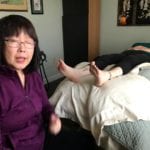I’m a doctor and I hate going to the doctor. The crowded waiting room, the crappy magazines, the guy talking too loudly on his cell phone. I don’t like any of it. They say physicians make the worst patients, and I’m no exception. But last year I went to see a doctor as a favor to my father, who has been begging me for years to visit a dermatologist. I’m Irish, I have fair skin, I grew up in Florida, and melanoma runs in my family. It seems silly not to go, right?
I made an appointment at a dermatology clinic affiliated with my hospital — I’m an assistant professor of medicine at Weill Cornell Medical College in Manhattan — and headed there one afternoon last spring. It was a new clinic on the Upper West Side, and when I arrived I was pleasantly surprised to discover that I was the only person in the spotless waiting room.
After being called into an exam room, I stripped off my clothes and slipped into one of those silly disposable gowns that let your butt hang out. My dermatologist entered the room a moment later.
He carefully examined my hands, my face, my chest, and my groin as I sat on a slab of butcher paper on an exam table, but he paused when he reached the soles of my feet. I thought that part of the examination was essentially a formality, a box he was required to check as part of some billing form, but I was wrong.
The doctor quietly asked me to roll onto my stomach so he could get a better view. Then he spent several minutes with his nose just inches from my feet, and eventually brought out a magnifying glass, which kinda freaked me out.
“Is everything okay?” I asked.
Unfortunately, he saw something. It wasn’t obviously cancer, but it wasn’t obviously not cancer. It was small and dark, and had irregular borders — like someone had dropped a dollop of ink onto my foot. As he examined the three-millimeter lesion, I tried to read the look on his face. Was he worried? I imagined what face I’d make if I saw cancer, or if I didn’t.
“Melanoma?” I asked. “Does it look like melanoma?”
He shook his head and said, “I can’t tell what it is.”
I pulled out my phone and did a quick search for “skin cancer of the foot,” which I was starting to worry I might have, based on the increasingly concerned look on my doctor’s face.
It turns out the sole of the foot is a clandestine hot spot for skin cancer. Recent studies of melanoma on the feet have shown a higher frequency of a genetic mutation in a gene called c-Kit, which makes a protein that’s a key player in cell growth. Lying on that butcher paper, I started to wonder what my c-Kit gene looked like.
Eventually, the dermatologist told me I could put my clothes back on. I was instructed to return to his clinic in a year, and to call the office if the shape, color, or size of the small thing on my foot changed. I checked it every month and thankfully, it didn’t change. Or so I thought.
When I returned for my follow-up appointment this January, the doctor noticed that the shape was different. I examine at least a dozen patients a day, performing a skin exam on all of them, and I couldn’t appreciate the change. But he could. He took a picture of the lesion and asked me to come back in just three months. If it changes again, he’s going to cut it out of me.
Most of us don’t think to check our soles because they’re shielded from sunlight and because we have to contort our bodies to see them. But if you’ve taken the time to read this, take 30 extra seconds and check the bottoms of your feet. If you see something, make an appointment to see a dermatologist or a reflexologist. And if you don’t see something, you should still make an appointment. I certainly wouldn’t have noticed that thing on my foot. And even when I knew about it, I still couldn’t tell that it was changing — potentially in a way that might one day kill me.
Thanks for not letting this one go, Dad.
The Writer – Matt McCarthy is an assistant professor of medicine at Cornell and a staff physician at Weill Cornell Medical Center.
In addition to helping our clients to balance their energy to build a strong immune system through Reflexology, we also check out people’s feet for dryness, unusual skin color, and pain spots. If you would like to schedule a FREE consultation, please call the Healing Place Medfield at 508 359-6463.









 The Healing Place LLC helps all ages to find relief from chronic pain, chronic digestive problems and balance hormones naturally. We practice COVID19 safety. Don’t forget to check on our online school HealingPlaceEnergySchool.com. Thank you.
The Healing Place LLC helps all ages to find relief from chronic pain, chronic digestive problems and balance hormones naturally. We practice COVID19 safety. Don’t forget to check on our online school HealingPlaceEnergySchool.com. Thank you.
Recent Comments